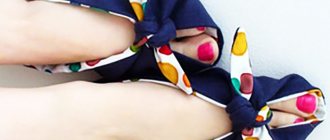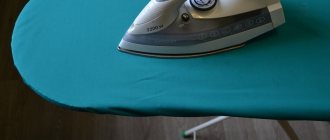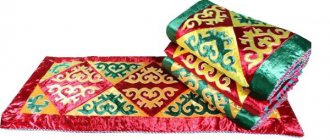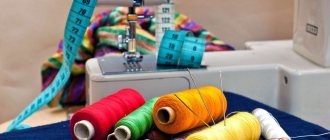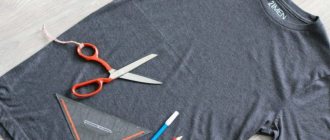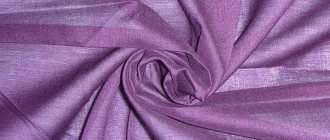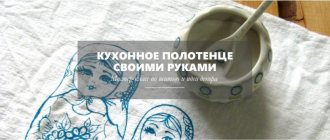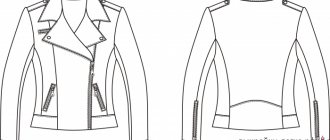The modern dynamic world dictates its own rules, and often many representatives of the fair sex prefer trousers and jeans as a more comfortable form of clothing. However, the skirt was and remains the most feminine part of the wardrobe, its necessary component. You can sew a half-sun skirt with your own hands; for beginners, step-by-step sewing instructions will be useful.
Half-sun skirt styles
Modeling a semi-sun skirt allows you to create interesting variations of the model.
Flare with pleats
A classic version of a flared skirt, complemented by pleats. Depending on the model, you can simulate one-sided, counter or bow folds.
With smell
You can use the scent to control the flare of the skirt. The model does not require seams.
These skirts are made:
- buttoned;
- with ties;
- on clasps.
High waist and wide belt
A wide belt emphasizes the waistline, creating a feminine silhouette. Models with a belt are especially suitable for slender girls.
Without belt
Such models are made with an elasticated waist or fastened with a button. Very comfortable skirts that do not restrict movement are especially in demand among plus-size ladies.
Features of sewing half-sun
Such skirts gained their popularity back in the 20th century and 30s. American fashionistas imitated the great Coco Chanel. She introduced the pencil and half-sun style into fashion. Every feminine girl of that time had these skirts. In 2000, there was a decline in the popularity of these styles, but since the beginning of 2010, more and more girls began to purchase and sew these skirts themselves. And in 2022, handmade things are gaining popularity.
Conical model
Many girls no longer want store-bought clothes and are trying to do everything not to look like each other. And by the way, making clothes yourself is several times cheaper than purchasing them in various fashion stores, and the quality will be many times higher, because good fabrics are always used when working independently.
It is very difficult to find clothing items that will fit almost all girls and emphasize their advantages. But still, there are some models that suit all body types. This will be a classic half-sun skirt. Its sophisticated silhouette can hide very wide hips or, conversely, balance their absence, can highlight the waistline and even visually enlarge the bust. It is recommended that every girl keep such products in her wardrobe. They go well with both heels and sneakers, sweaters or summer tops.
You might be interested in Sewing a bolero for a dress with and without patterns
Pattern with radius
Due to the fact that the skirt parts are cut at an angle of 45 degrees, they need to be lengthened. This will affect the parts of the back and front half in the middle. If the skirt is made from thin material, then it needs to be lengthened in its finished form. Allowances are required here (no more than 5 centimeters at the hem). Before sewing the parts together, it is advisable to fasten them well.
When creating a product from fabric with a satin weave, you must let the skirt hang for at least a day before straightening the edge. If a lightweight material is selected for the work, then the product can be sewn with an elastic band. At the same time, it can be inserted either along the entire waist line, or separately - two elastic bands along the side seams.
Construction of a drawing
There is no need to make such a skirt from striped materials, as it will be very difficult to match the pattern. Moreover, in this case, fabric consumption will increase. When creating a skirt from satin, you need to consider that it will look different from the front and back. This is due to the bias cut.
Which fabric to choose
As stated above, the main requirement for the material is good ductility.
The type and composition of the fabric is selected taking into account the season for which the skirt is made, the experience of the seamstress, and the characteristics of the model.
Let's look at some options:
- tweed is an excellent choice for a warm skirt. Woolen fabric with a textured surface drapes well and forms clear folds. Not suitable for women with large hips, as it will significantly increase their volume;
- tulle is a light, homogeneous material, ideal for creating fluffy skirts;
- denim is a natural material with a universal color combination, suitable for everyday wear;
- leather - used mainly by young girls. Leather skirts are good in the off-season, especially if they are mid-length or maxi;
- knitwear is an affordable material, holds its shape well (especially thick), thin knitwear is good for summer skirts;
- chiffon - breathable, airy, transparent material is especially suitable for summer skirts;
- Chintz and cotton fabrics are a good choice for beach skirts.
Choice of fabric for sewing.
Such a skirt should be soft and light, made of natural or synthetic fabric. The best products will be made from natural silk. But if there is a strong wind when walking outside, then you should discard the skirt, as it will easily lift it to the waist. Based on this, when thinking about what material to choose for a semi-sun skirt, you need to take care of buying a lining. A small mesh made of artificial threads works well.
Summer looks
For the summer, you can make a lining of chiffon or tulle. It will look like a bell if a thin wire is sewn along the edge of the product. The product will be light, the petticoat will keep the layers from sticking to the body. It’s both beautiful in appearance and not stuffy, despite the large amount of fabric.
The success of the finished product will depend on the correct choice of fabric. For the autumn version of the skirt, you can take leather or draped fabric.
But no matter what material was chosen, you only need to work on a sewing machine. So that the stitching is smooth and strong. No matter how skilled the needlewoman is, it is difficult to make a high-quality skirt by hand.
You may be interested in: Patterns and sewing procedure for a women's belt bag
Cotton lace hem decoration
Many girls decorate the hem of their summer skirt with light lace. Which makes her soft and very cute.
How to distinguish between a half-sun skirt and a sun skirt
These two models are very similar to each other. But still they are different. They differ, first of all, in appearance. The semi-sun skirt is not as flared and has fewer pleats.
This is due to the fact that the sun skirt is made from a full circle - see the pattern below.
Depending on the width of the fabric, it can be either a seamless product or with several seams.
In turn, for a half-sun skirt, the pattern is made from a semicircle. There will definitely be at least one seam on it.
Let's figure out how to construct a pattern for such a half-sun skirt.
How to calculate how much fabric is needed for a half-sun skirt
There are two main layout options - for a skirt with one seam and for a model with two seams.
For the first case, which is discussed in detail above, we calculate the fabric consumption as twice the larger radius plus fabric for allowances and making a belt.
For the second case, the patterns are laid out in a mirror image, with a slight overlap. With this method we get some savings in the amount of fabric.
It depends on the amount of overlap of the patterns.
Another layout option is to place the patterns in a “jack”.
In this case we will also get some material savings.
Let's look at a specific example of how we can calculate the required length of fabric for a half-sun skirt.
Initial data:
- fabric width – 150 cm;
- OT = 80 cm;
- DI = 100 cm.
Calculation
We calculate R1 = FROM: π = 80 cm: 3.14 = 25.4 cm.
R2 = R1 + CI = 25.4 cm + 100 cm = 125.4 cm.
Next we need the Pythagorean theorem:
a2 + b2 = c2.
In it:
- a = 150 cm (fabric width);
- b – required length of fabric;
- c = R2 + R2 = 250.8 cm.
Hence b2 = c2 – a2;
b2= 250.82 – 1502 = 62900.64 – 22500 = 40400.64.
We get b = 201 cm.
The fabric savings amounted to almost half a meter: 250.8 – 201 = 49.8 cm.
Making a pattern and sewing is easy
To avoid mistakes, we recommend that a beginning seamstress lay out the fabric on a table or floor. The construction must be done on the wrong side of the product. When making calculations, you will need a center to draw circles from it, the radius of which was determined in advance. The second half of the product is built in a similar way. If you have a ready-made pattern, for example from a magazine for sewing enthusiasts, check all the dimensions and you can begin further work. Perform the layout on the spread of the canvas and cut out the details.
If you are sewing a skirt for a child, then the fabric can be folded in 2 or 4 layers, pinned together, and then constructed. This is very convenient and fast to do. You need to cut without unrolling the material.
Assembly algorithm:
- Finish the side edges with an overlock stitch.
- Sew the halves of the product together, leaving 18 cm for the zipper.
- Press the side seams.
- Cut out the belt and duplicate the part with adhesive interlining.
- Overcast one long section, fold in half and iron.
- Sew the raw edge of the waistband to the top of the skirt.
- Pin or baste the zipper and machine stitch it.
- Bend the belt and stitch it, perform a finishing stitch.
- Process the bottom of the product.
Now the long-awaited new thing is ready, it’s time to try it on.
As you can see, cutting and sewing a circle skirt is easy; even a novice seamstress can handle the task. And if you still don’t want to bother, go to the studio and replenish your wardrobe with fashionable things.
Ready-made patterns for a half-sun skirt with two seams
Patterns are calculated for sizes:
- 40: FROM = 64 cm;
- 42: FROM = 68 cm;
- 44: FROM = 72 cm;
- 46: FROM = 76 cm;
- 48: FROM = 80 cm;
- 50: FROM = 84 cm;
- 52: FROM = 88 cm;
- 54: FROM = 94 cm;
- 56: FROM = 100 cm;
- 58: FROM = 106 cm;
- 60: FROM = 112 cm.
Cutting is done on fabric one and a half meters wide.
Reviews
Natalia, 29 years old: With any method of cutting a skirt, do not forget about seam allowances. A couple of times, due to such an oversight, I had to shorten the product by a couple of centimeters, but in the end it turned out even better than I wanted. Another tip: in some places of the material the thread will still have an oblique direction, so let the material hang before starting to work the lower part.
Anastasia, 32 years old: I sewed a skirt with pleats. After the calculations were made, I drew the necessary circles. I also advise you to mark the position of all the folds - it’s more convenient. In addition, do not spare pins when pinning fabric patterns, otherwise the material will shift under the scissors. Thanks to the right calculations, my pleated half-sun skirt turned out to be simply chic.
Yulia, 36 years old: Recently I have become interested in sewing. I decided to start simple - I chose a skirt in the shape of a semicircle, and a single-seam one. The patterns are really easy to make. Fold the material in half, and position the pattern so that one of the side cuts coincides with the fold of the material. You trace, cut out and all that remains is to sew one seam, and don’t forget the waistband and bottom.
Half-sun skirt with one seam: step-by-step master class
To sew a half-sun skirt with your own hands, you need to prepare:
- suit fabric, width 1.5 m;
- hidden zipper;
- doublerin;
- narrow tape for eyelets;
- threads, sewing tools.
How to sew a half-sun skirt
Required measurements:
- waist circumference (WC) – 63 cm;
- product length (DI) – 53 cm.
We calculate the first radius FROM: 3.14 = 20 cm.
We will do the markings directly on the fabric, without creating a paper pattern for the half-sun skirt with our own hands. For beginning seamstresses, doing this with your own hands is sometimes even easier than marking according to a pattern.
Fold the fabric in half and form the first radius of the half-sun skirt from the corner of the fold of the fabric.
We retreat from the edge from 1 to 1.5 cm for the seam allowance.
Then we draw the second radius, setting aside the length of the skirt (= 53 cm) + hem allowance (= 1.5 cm). Only 54.5 cm.
Considering that the section of the panel cut on the bias will sag more than the rest, we shorten the central part by 1 cm. We draw a new line for the lower cut of the half-sun skirt on the fabric, leaving 54.5 cm at the edges and 53.5 cm in the center.
We begin to cut the half-sun skirt, not forgetting to allow an allowance of one and a half cm along the waist line.
We cut out the blank for the belt in the form of a rectangle 9 cm wide and 63 cm long + 7 cm = 70 cm. Folding it in half along the width, we will sew it together. When finished, the belt will be 3.5 cm wide.
We strengthen the belt with doublerin.
We overlock the side seams and iron them.
We prepare special feet for sewing in a zipper. We have three of them.
With the first (regular) foot, we grind the edge of the braid at a distance of 1 mm.
With the second paw we go around the teeth of the zipper and attach it.
With the third foot we sew the central seam from the zipper to the bottom of the skirt.
How to make this process convenient for you depends on the capabilities of your machine. It is important that it turns out neatly and does not have to be redone.
Iron the completed seam and zipper.
We overlock the lower sections of the skirt and one edge of the belt.
Next, we’ll figure out how to sew a belt to a skirt. Its location should be symmetrical relative to the center of the skirt. On the skirt we find the center of the panel in front. On the belt blank we find the place corresponding to this center. To do this, measure 1 cm on the workpiece (seam allowance), then set aside half of 63 cm (OT). Mark the center of the belt. From it in both directions we set aside 63:4 = 15.8 cm. This is the place of the imaginary side seams of the skirt.
We pin together the control points of the belt and the upper sections of the skirt. We chop off the remaining sections, placing the skirt on the belt.
Attach the belt with an allowance of 1 cm.
Fold back the waistband allowance and press the seam.
We measure 3.5 cm from the seam and draw a fold line.
Turning it to the wrong side, we stitch the fastener opening around the perimeter when folded. We trim the corners. Turn it right side out and iron it.
Cut pieces for loops from a narrow ribbon. We baste or pin the second section of the belt, inserting the loops.
We machine stitch into the belt stitching seam, attaching the lapel of the belt. At the same time, you sew the loops in this seam.
Now let's look at how to hem the bottom of a skirt.
It is convenient to use templates for this operation. It’s good if they are available for different hem sizes.
Our bottom allowance is 1.5 cm. Using the template, mark the bottom edge.
We tuck the cuts carefully; if folds have formed somewhere, you need to redo them. We make a basting seam and iron it.
All we have to do is hem the skirt with decorative stitching.
We make a loop on the belt.
Sew on the button.
Iron the product.
Footage calculation
The important parameter here is the size of the product. The skirt will be one-piece if it is intended for a child, and the length is assumed to be knee-length. This limitation is due to the width of the fabric. You can sew the product from two parts; for assembly you will need to lay the side seams.
Before purchasing a cut, you must accurately calculate the consumption, otherwise you will not be able to cut out the skirt. To find out how much fabric you will need, we recommend making constructions on paper at a scale of 1:10. To do this, you need to measure the width of the fabric, and then build 2 circles from one center with radii R (calculated by dividing the measured waist circumference by 6, minus 0.5 cm) and R1 (equal to the length of the skirt, taking into account the allowance). Make a similar construction nearby, only from the other edge. Then use a scale ruler to measure the bottom of the drawing and determine the required yardage of fabric.
How to calculate the amount of fabric for a suit?
If this is a men's or women's suit, then the length of the sleeve is added to the length of the jacket with allowances for hemming the bottom of the garment and the sleeves. The fabric consumption for the shirt is also calculated. To calculate the fabric consumption for trousers, measure the length of the trousers to the waist, and add 15 - 25 cm to this measurement.
Interesting materials:
What are the dangers of crib bumpers? Why are acids dangerous? Why are Reduxin tablets dangerous? How to spray phlox in the fall? How to open compass files? How to open a WebM file? How to clean the floor from dirt? How to clean the floor from stains? What does the Basilisk eat? What does a hare eat in the steppe?

